Long Term Monitoring of Health Inequalities: Headline Indicators – October 2015
Annual update of the 'Long-term Monitoring of Health Inequalities' headline indicators.
Inequalities in morbidity and mortality indicators
The relative index of inequality (RII) indicates the extent to which health outcomes are worse in the most deprived areas compared to the average throughout Scotland. While comparisons of RII between indicators are possible, they should be made with some caution, in particular where absolute values are significantly higher or lower in the compared indicators or where the measurement scale differs (for example, relative inequalities in Mental Wellbeing scores, which are based on responses to survey questions, compared to relative inequalities in an age-standardised mortality rate).
The following charts group indicators in this report into broadly comparable categories: the first shows hospital admissions and incidence of conditions for people belonging to the under 75 age group; while the second shows mortality rates in the 45-74 age group for three causes of death.
Although relative inequalities in alcohol-related hospital admissions have declined over the long term and heart attack hospital admissions inequalities have increased in the years since 2008, relative inequalities have remained highest in the alcohol-related indicators throughout the period covered by this report. Inequalities in cancer incidence have been more stable in relative terms.
Figure 4.1 Relative Index of Inequality (RII) Selected morbidity indicators (ages <75 years) Scotland 1997 - 2013
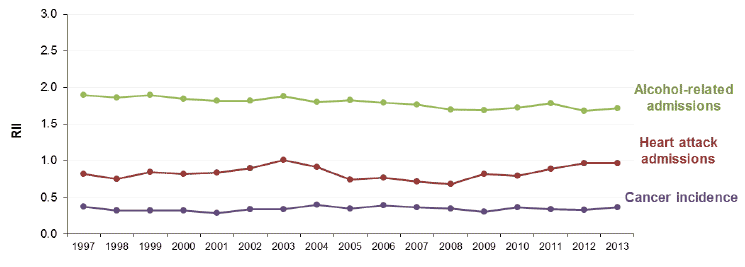
Despite a drop in 2013, relative inequalities in CHD mortality among adults aged 45-74 have increased over the long term. Alcohol-related deaths relative inequalities have shown more year to year fluctuation but also dropped in the last year.
Although RII in cancer mortality has increased slightly over the longer term, inequalities remain widest in alcohol-related deaths and coronary heart disease deaths.
Figure 4.2 Relative Index of Inequality (RII) Mortality indicators (ages 45-74 years) Scotland 1997-2013
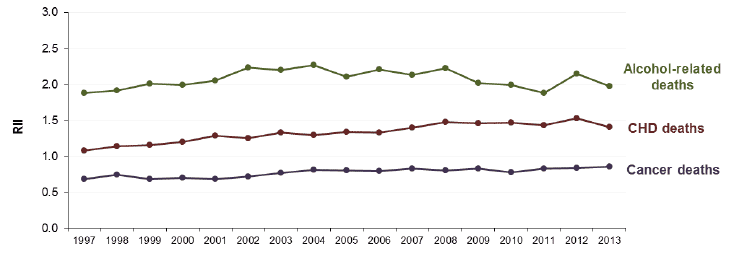
Coronary Heart Disease - first ever hospital admission for heart attack aged under 75 years
Trends in heart attack hospital admissions
In 2013, around 4,700 new cases of heart attack (for those aged under 75 years) were recorded in Scottish hospitals. The rate of admissions is 32% lower than in 1997 but, despite a small decrease in the last year, the recent trend has been increasing after admissions reached their lowest level in 2007.
Inequalities in hospital heart attack hospital admissions, 2013
The latest admission rate in Scotland's most deprived areas is 2.4 times greater than that of the least deprived (156.5 cases per 100,000 compared to 65.1 per 100,000).
Figure 5.1 Hospital admissions for heart attack among those aged <75y by Income-Employment Index, Scotland 2013 (European Age-Standardised rates per 100,00)
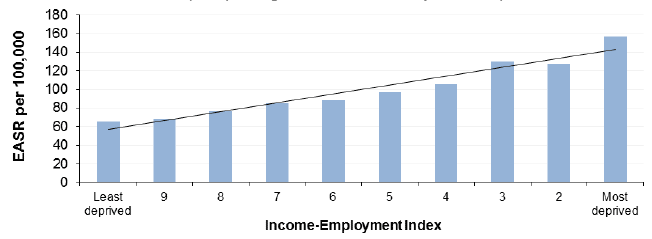
Trends in relative inequalities
Relative inequality levels for heart attack hospital admissions have fluctuated over time. However, despite little change in the last year, there had been a general increasing trend since RII reached its lowest level in 2008.
Figure 5.2 Relative Index of Inequality (RII): Hospital admissions for heart attack <75y Scotland 1997-2013
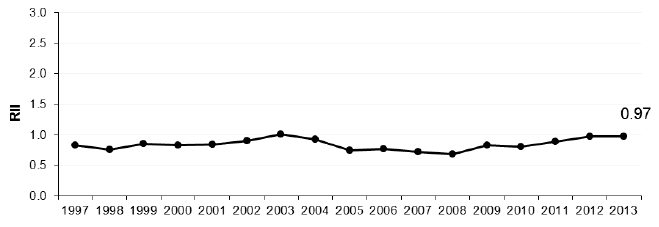
Heart attack hospital admission rates (aged < 75) have generally been approximately 2-3 times higher in the most deprived areas compared to the least deprived areas. In 2013, rates are 2.4 times higher in the most deprived areas than in the least deprived.
Trends in absolute inequalities
Absolute inequality has also fluctuated. Following consecutive falls between 2003 and 2007, the gap widened before narrowing slightly in the most recent year.
Figure 5.3 Absolute Gap: Hospital admissions for heart attack <75y Scotland 1997-2013 (European Age-Standardised Rates per 100,000)
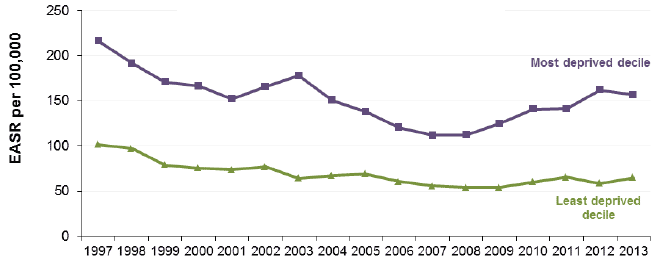
In 2013, the heart attack admission rate in the most deprived areas was 156.5 per 100,000, compared to a rate of 65.1 per 100,000 in the least deprived areas (a gap of 91.4 per 100,000).
The gap was largest in 1997, when the admissions rate was 216.5 per 100,000 and 101.9 per 100,000 in the most and least deprived areas respectively (a gap of 114.6 per 100,000).
Table 5.1: Trends in heart attack hospital admissions (aged <75), 1997-2013
| Total admissions | Population | Rate per 100,000 (EASR) | |
|---|---|---|---|
| 1997 | 5,764 | 4,740,269 | 145.1 |
| 1998 | 5,676 | 4,729,975 | 141.5 |
| 1999 | 5,101 | 4,721,298 | 126.6 |
| 2000 | 4,812 | 4,708,667 | 118.4 |
| 2001 | 4,776 | 4,703,661 | 116.9 |
| 2002 | 4,833 | 4,701,958 | 116.6 |
| 2003 | 4,569 | 4,702,431 | 109.0 |
| 2004 | 4,413 | 4,714,233 | 103.9 |
| 2005 | 4,047 | 4,735,320 | 94.2 |
| 2006 | 3,750 | 4,752,425 | 86.4 |
| 2007 | 3,549 | 4,783,452 | 80.4 |
| 2008 | 3,655 | 4,811,453 | 81.7 |
| 2009 | 3,851 | 4,835,007 | 84.9 |
| 2010 | 4,377 | 4,858,058 | 95.4 |
| 2011 | 4,537 | 4,888,316 | 97.7 |
| 2012 | 4,747 | 4,895,114 | 100.8 |
| 2013 | 4,697 | 4,903,074 | 98.8 |
Coronary Heart Disease (CHD) - deaths aged 45-74 years
Trends in CHD deaths
Since 1997, there has been a considerable decrease in CHD mortality amongst the population aged 45-74 years. The death rate has fallen by 64% to 133.7 per 100,000, the lowest rate in the reporting period (1997 to 2013). However, CHD remains one of Scotland's biggest causes of premature mortality, with around 2,500 deaths occurring in this age group in 2013.
Inequalities in CHD deaths, 2013
In 2013, the CHD mortality rate was 3.4 times greater in Scotland's most deprived areas compared to the least deprived (245.9 compared to 73.3 deaths per 100,000 population).
Figure 6.1 CHD mortality amongst those ages 45-74y by Income-Employment Index, Scotland 2013 (European Age-Standardised Rates per 100,000)
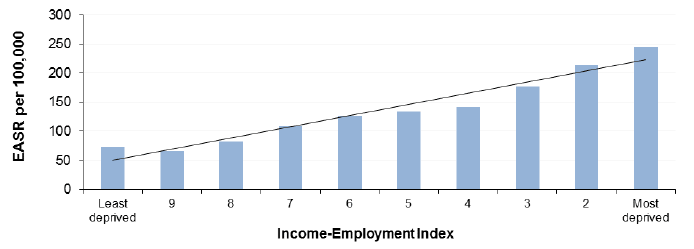
Trends in relative inequalities
Relative inequalities in CHD mortality grew steadily over time until 2008. Since then they have fluctuated (in the range 1.40-1.52) with no clear pattern. The decrease in 2013 brings RII to its lowest level since 2007.
Figure 6.2 Relative Index of Inequality (RII): CHD mortality 45-74y Scotland 1997-2013

In 1997, CHD mortality rates were 2.8 times higher in the most deprived areas compared to the least deprived areas. Rates have typically been 3-4 times higher in the most deprived areas (3.4 times higher in 2013).
Trends in absolute inequalities
Absolute inequality has reduced over time, with consecutive decreases from 1998 to 2002 and then again from 2003 to 2006. The gap has continued to narrow, and the difference between most and least deprived areas is now around 56% lower than in 1998.
Figure 6.3 Absolute Gap: CHD mortality 45-74 years, Scotland 1997-2913 (European Age-Standardised Rates per 100,00)
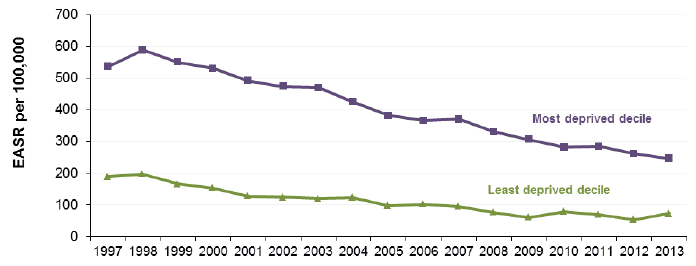
Table 6.1: Trends in coronary heart disease deaths (aged 45-74), 1997-2013
| Number of deaths | Target population size | Rate per 100,000 (EASR) | |
|---|---|---|---|
| 1997 | 5,887 | 1,635,590 | 372.5 |
| 1998 | 5,675 | 1,646,711 | 357.9 |
| 1999 | 5,389 | 1,658,124 | 338.9 |
| 2000 | 4,858 | 1,670,660 | 303.9 |
| 2001 | 4,483 | 1,687,422 | 279.3 |
| 2002 | 4,310 | 1,706,141 | 265.9 |
| 2003 | 4,197 | 1,727,112 | 256.3 |
| 2004 | 3,840 | 1,751,037 | 232.3 |
| 2005 | 3,721 | 1,774,865 | 222.3 |
| 2006 | 3,393 | 1,799,382 | 200.8 |
| 2007 | 3,374 | 1,827,320 | 196.6 |
| 2008 | 3,155 | 1,856,874 | 180.9 |
| 2009 | 2,857 | 1,885,693 | 160.7 |
| 2010 | 2,811 | 1,914,226 | 156.6 |
| 2011 | 2,592 | 1,941,253 | 142.6 |
| 2012 | 2,584 | 1,964,203 | 139.7 |
| 2012 | 2,515 | 1,986,202 | 133.7 |
Cancer - incidence rate aged under 75 years
Trends in cancer incidence
The number of new cases of cancer incidence among people aged under 75 has continued to increase and, in 2013, was more than 20,500. This is explained in part by Scotland's ageing population.
The age-standardised cancer incidence rate was broadly stable between 1997 and 2005 and, following a period of increase, has generally declined since 2009.
Inequalities in cancer incidence, 2013
In 2013, there were 548.2 cases per 100,000 people in the most deprived areas, compared to 380.3 per 100,000 in the least deprived.
Figure 7.1 Cancer incidence amongst those aged <75y by Income-Employment Index, Scotland 2013 (European Age-Standardised Rates per 100,00)
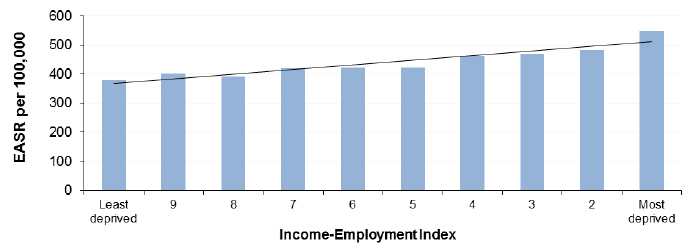
Cancer incidence is more common in the most deprived areas of Scotland. However, this is not the case for all types of cancer.[4] This is driven in part by variations in screening uptake, leading to socially patterned rises in cancer incidence and, in turn, cancer survival for some types of cancer in the least deprived areas.
Of the most common types, the absolute gap between most and least deprived areas was largest for cancer of the trachea, bronchus and lung (2013 rates were 143.9 and 30.9 per 100,000 population in the most and least deprived areas respectively).
Trends in relative inequalities
Changes in the relative index of inequality over time have been minimal and show no clear pattern, fluctuating between 0.29 and 0.40.
Figure 7.2 Relative Index of Inequality (RII): Cancer Incidence <75y Scotland 1996-2013

Incidence rates have typically been 30-50% higher in the most deprived areas in Scotland compared to the least deprived (44% in 2013).
Trends in absolute inequalities
Absolute inequality levels in cancer incidence have fluctuated over time. Rates in both the least and most deprived areas of Scotland have shown no clear pattern stable since 1997.
Figure 7.3 Absolute Gap: Cancer incidence <75y, Scotland 1996-2013 (European Age-Standardised rates per 100,00)
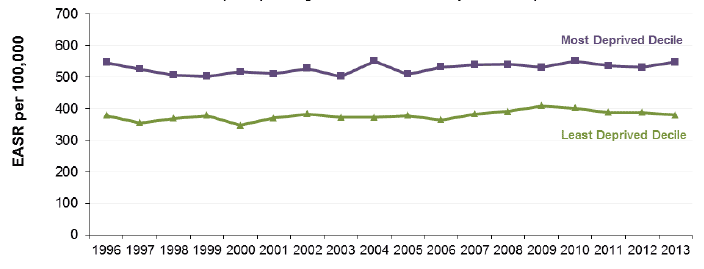
The gap was widest in 2004 (rates of 551.1 per 100,000 and 372.9 per 100,000 in the most and least deprived areas, respectively) but narrowed to its lowest level the following year (rates of 509.5 per 100,000 and 379.6 per 100,000, respectively).
Table 7.1: Trends in cancer incidence (aged < 75), 1997-2013
| Number of new cases | Target population size | Rate per 100,000 (EASR) | |
|---|---|---|---|
| 1996 | 18,128 | 4,754,906 | 452.7 |
| 1997 | 17,167 | 4,740,269 | 427.4 |
| 1998 | 17,109 | 4,729,975 | 424.3 |
| 1999 | 16,914 | 4,721,298 | 417.5 |
| 2000 | 17,138 | 4,708,667 | 420.6 |
| 2001 | 17,147 | 4,703,661 | 418.9 |
| 2002 | 17,530 | 4,701,958 | 423.6 |
| 2003 | 17,574 | 4,702,431 | 420.8 |
| 2004 | 18,159 | 4,714,233 | 430.3 |
| 2005 | 17,987 | 4,735,320 | 421.9 |
| 2006 | 18,167 | 4,752,425 | 423.3 |
| 2007 | 18,775 | 4,783,452 | 430.8 |
| 2008 | 19,449 | 4,811,453 | 439.7 |
| 2009 | 19,999 | 4,835,007 | 446.6 |
| 2010 | 20,015 | 4,858,058 | 441.9 |
| 2011 | 20,208 | 4,888,316 | 441.3 |
| 2012 | 20,296 | 4,895,114 | 436.8 |
| 2013 | 20,598 | 4,903,074 | 437.7 |
Cancer- deaths aged 45-74 years
Trends in cancer deaths
The cancer mortality rate amongst those aged 45-74 years has fallen by around 25% since 1996 (from 529.8 to 399.8 per 100,000 population, in 2013). The number of deaths each year has also reduced in this period, from around 8,400 to 7,500.
Inequalities in cancer deaths, 2013
Of people in the 45-74 year age group, those in Scotland's most deprived areas are more than twice as likely to die of cancer than those in the least deprived (642.4 deaths per 100,000 population compared to 270.1 per 100,000 population, in 2013).
Figure 8.1 Cancer mortality amongst those aged 45-74y by Income-Employment Index, Scotland 2013 (European Age-Standardised Rates per 100,000)
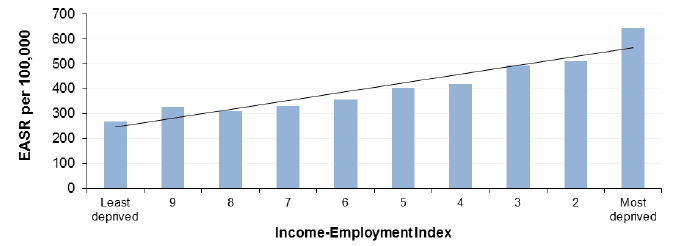
As is the case for cancer incidence, inequality levels vary when examining deaths by cancer type[5]. As described in the previous section, variations in screening uptake may lead to socially patterned rises in cancer incidence and, in turn, cancer survival (therefore having a possible effect on mortality) for some types of cancer.
The most considerable differences between rates in the most and least deprived areas are observed for cancer of the trachea, bronchus and lung (261.1 compared to 57.0 per 100,000 population).
Trends in relative inequalities
Relative inequalities for this indicator have continued to increase over time. Despite little variation since 2007, the latest RII figure is the largest in the time series (0.86, compared to 0.68-0.81 in the years 1997 to 2006).
Figure 8.2 Relative Index of Inequality (RII): Cancer mortality 45-74y Scotland 1996-2013
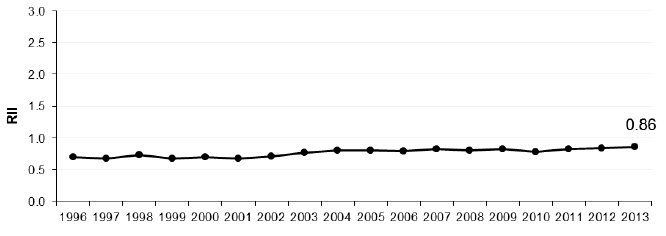
Cancer mortality rates (aged 45-74) have been approximately two times higher in the most compared to least deprived areas (2.4 times higher in 2013). In 1997, rates were two times higher in the most deprived areas.
Trends in absolute inequalities
Levels of absolute inequality for cancer deaths have fluctuated since 1997. The gap was narrowest in 2010 when rates were 310.3 per 100,000 in the least deprived areas and 615.1 in the most deprived areas. In the last year, the gap increased and now is at its widest level since 2007.
Figure 8.3 Absolute Gap: Cancer mortality 45-74y, Scotland 1996-2013 (European Age-Standardised Rates per 100,000)
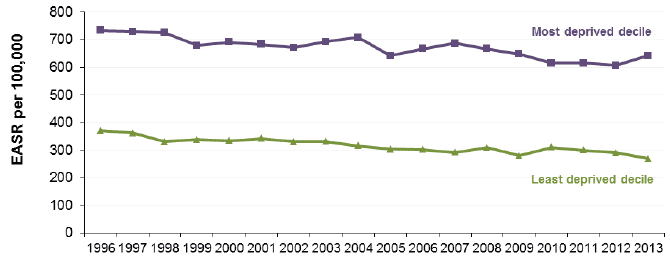
Table 8.1: Trends in cancer mortality (aged 45-74), 1997-2013
| Number of deaths | Target population size | Rate per 100,000 (EASR) | |
|---|---|---|---|
| 1996 | 8,402 | 1,631,224 | 529.8 |
| 1997 | 8,068 | 1,635,590 | 509.1 |
| 1998 | 7,995 | 1,646,711 | 501.9 |
| 1999 | 7,904 | 1,658,124 | 494.4 |
| 2000 | 7,776 | 1,670,660 | 484.8 |
| 2001 | 7,903 | 1,687,422 | 489.2 |
| 2002 | 7,850 | 1,706,141 | 481.2 |
| 2003 | 7,706 | 1,727,112 | 467.4 |
| 2004 | 7,678 | 1,751,037 | 460.9 |
| 2005 | 7,606 | 1,774,865 | 451.8 |
| 2006 | 7,486 | 1,799,382 | 441.3 |
| 2007 | 7,569 | 1,827,320 | 439.5 |
| 2008 | 7,536 | 1,856,874 | 431.0 |
| 2009 | 7,481 | 1,885,693 | 421.2 |
| 2010 | 7,394 | 1,914,226 | 411.1 |
| 2011 | 7,428 | 1,941,253 | 408.5 |
| 2012 | 7,514 | 1,964,203 | 406.2 |
| 2013 | 7,520 | 1,986,202 | 399.8 |
Alcohol - first hospital admission aged under 75 years[6]
Trends in alcohol-related admissions
The hospital admission rate for alcohol-related conditions amongst those aged under 75 years has fallen over time, with an 18% decrease between 1996 and 2013 (289.8 and 236.8 cases per 100,000 respectively).
Inequalities in alcohol-related admissions, 2013
These types of admissions are more than five times as common in the most deprived areas of Scotland compared to the least (503.5 compared to 97.7 cases per 100,000).
Figure 9.1 Alcohol related hospital admissions amongst those aged <75y by Income-Employment Index, Scotland 2013 (European Age-Standardised Rates per 100,000)
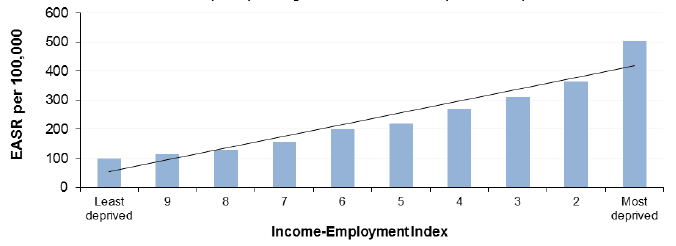
Trends in relative inequalities
A general downward trend was observed in relative inequalities for alcohol-related admissions between 1997 and 2008 (RII declining from 1.90 to 1.70). Since then, there has been very little change in the RII figure (1.71 in 2013).
Figure 9.2 Relative Index of Inequality (RII): Alcohol related hospital admissions <75y Scotland 1996-2013
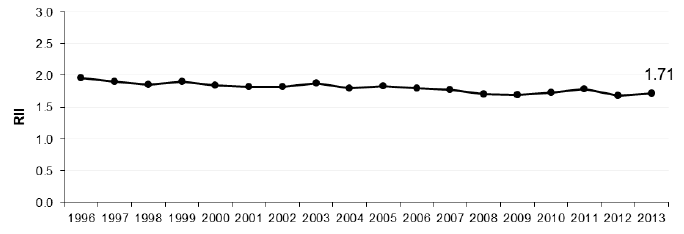
In 1997, alcohol-related admission rates were seven times higher in the most deprived areas compared to the least deprived. For the last seven years, rates have been around five times higher in the most deprived areas compared to the least deprived.
Trends in absolute inequalities
Absolute inequality in alcohol-related admissions has generally reduced over time, and, in 2012, was at its lowest level in the time series. Despite this trend there has been fluctuation, including a slight widening of the gap in the most recent year.
The reduction over the long term in both relative and absolute inequality is largely due to the fall in deaths in the most deprived areas, which have been reducing faster than those in the least deprived.
Figure 9.3 Absolute Gap: Alcohol related hospital admissions <75y Scotland 1996-2013 (European Age-Standardised Rates per 100,00)
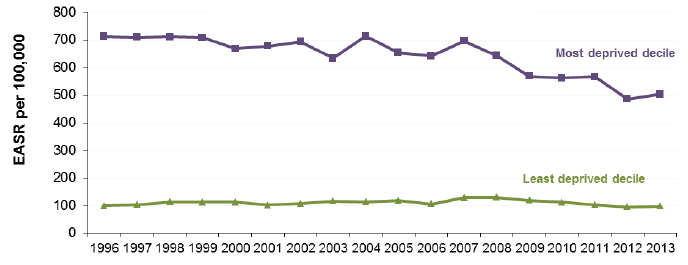
Table 9.1: Trends in alcohol-related hospital admissions (aged < 75), 1997-2013
| Number of admissions | Target population size | Rate per 100,000 (EASR) | |
|---|---|---|---|
| 1996 | 12,787 | 4,754,906 | 289.8 |
| 1997 | 12,918 | 4,740,269 | 292.6 |
| 1998 | 13,316 | 4,729,975 | 300.7 |
| 1999 | 13,217 | 4,721,298 | 298.2 |
| 2000 | 12,786 | 4,708,667 | 286.6 |
| 2001 | 13,469 | 4,703,661 | 300.3 |
| 2002 | 13,492 | 4,701,958 | 299.9 |
| 2003 | 12,996 | 4,702,431 | 290.0 |
| 2004 | 14,084 | 4,714,233 | 312.5 |
| 2005 | 13,346 | 4,735,320 | 293.8 |
| 2006 | 13,595 | 4,752,425 | 295.3 |
| 2007 | 14,641 | 4,783,452 | 313.5 |
| 2008 | 14,222 | 4,811,453 | 302.3 |
| 2009 | 12,891 | 4,835,007 | 272.9 |
| 2010 | 12,307 | 4,858,058 | 258.7 |
| 2011 | 12,264 | 4,888,316 | 256.2 |
| 2012 | 11,556 | 4,895,114 | 240.9 |
| 2013 | 11,225 | 4,903,074 | 236.8 |
Alcohol - deaths aged 45-74 years
Trends in alcohol-related deaths
Alcohol-related deaths among those aged 45-74 years, which peaked at around 1,900 in 2006, have continued to fall. At 1,435 deaths - a rate of 73.0 per 100,000 - deaths in 2013 are at the lowest level in the reporting period.
Inequalities in alcohol-related deaths, 2013
Despite a continuing decline in alcohol-related deaths, the mortality rate in Scotland's most deprived areas is almost seven times higher than that observed in the least deprived (171.8 compared to 24.9 per 100,000 population).
Figure 10.1 Alcohol related mortality amongst those ages 45-74y by Income-Employment Index, Scotland 2013 (European Age-Standardised Rates per 100,000)
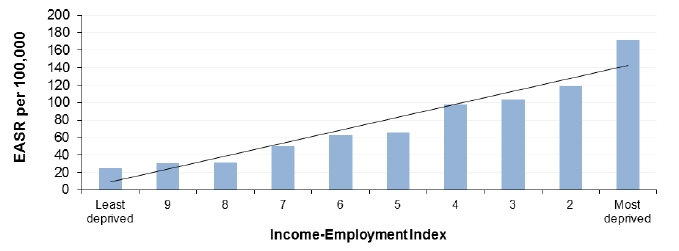
Trends in relative inequalities
Relative inequalities in alcohol related deaths increased between 1997 and 2002 (RII increasing from 1.88 to 2.23), remained at around this level until 2006 (ranging between 2.10 and 2.23) and have slightly reduced in the years since, despite another peak in 2012.
Figure 10.2 Relative Index of Inequality (RII): Alcohol related mortality 45-74y Scotland 1997-2013
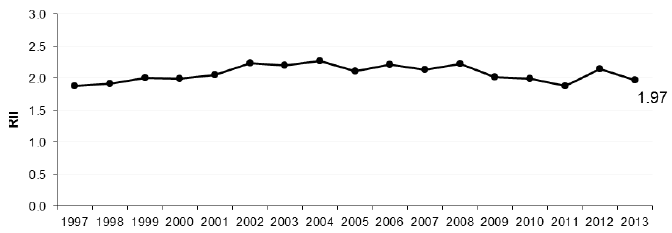
In 2013, alcohol-related deaths were seven times higher in the most deprived areas compared to the least deprived. The relative range between the most and least deprived areas has fluctuated, peaking in 2002 when death rates were more than twelve times higher in the most deprived areas.
Trends in absolute inequalities
Although alcohol-related deaths in the least deprived areas have remained reasonably static since 1997, there has been considerable fluctuation in the most deprived area deaths.
Despite occasional increases in the intervening years, most deprived area deaths have fallen since 2002. Following three years of consecutive decreases they are now, like absolute inequality levels, at the lowest level in the time series.
Figure 10.3 Absolute Gap: Alcohol related mortality 45-74y Scotland 1997-2013 (European Age-Standardised Rates per 100,000)
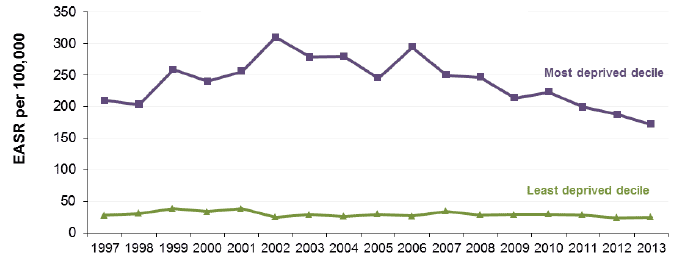
Table 10.1: Trends in alcohol-related deaths (aged 45-74), 1997-2013
| Number of deaths | Target population size | Rate per 100,000 (EASR) | |
|---|---|---|---|
| 1997 | 1,318 | 1,635,590 | 81.1 |
| 1998 | 1,415 | 1,646,711 | 86.4 |
| 1999 | 1,508 | 1,658,124 | 91.5 |
| 2000 | 1,489 | 1,670,660 | 89.8 |
| 2001 | 1,565 | 1,687,422 | 93.5 |
| 2002 | 1,753 | 1,706,141 | 103.5 |
| 2003 | 1,749 | 1,727,112 | 102.1 |
| 2004 | 1,764 | 1,751,037 | 101.5 |
| 2005 | 1,790 | 1,774,865 | 101.6 |
| 2006 | 1,899 | 1,799,382 | 106.7 |
| 2007 | 1,801 | 1,827,320 | 99.5 |
| 2008 | 1,782 | 1,856,874 | 97.0 |
| 2009 | 1,611 | 1,885,693 | 86.4 |
| 2010 | 1,674 | 1,914,226 | 88.5 |
| 2011 | 1,571 | 1,941,253 | 82.4 |
| 2012 | 1,441 | 1,964,203 | 74.3 |
| 2013 | 1,435 | 1,986,202 | 73.0 |
All-cause mortality aged 15-44 years
Trends in all-cause mortality aged 15-44
The mortality rate amongst those aged 15-44 in Scotland has reduced from 118.3 per 100,000 in 2006 to 100.1 per 100,000 in 2013. Between 1997 and 2005, the mortality rate ranged between 109.3 and 122.0 per 100,000.
This means there was a total of 1,990 deaths of people aged 15-44 in Scotland in 2013, compared to 2,482 in 2006. The 1,990 deaths in 2013 included 354 probable suicides, 356 drug-related deaths and 35 deaths from assault.
While the rates of probable suicide and deaths from assault in this age group reached their lowest levels in 2013, drug-related death rates almost trebled between 1997 and 2008. In 2013, the drug-related death rate (17.9 per 100,000) is still higher than it was throughout the decade between 1997 and 2006, ranging from 8.9 to 17.1 per 100,000.
Inequalities in all-cause mortality aged 15-44, 2013
The death rate amongst people aged 15-44 years is five times higher in the most deprived areas (199.7 per 100,000) compared to the least deprived (40.1 per 100,000).
Figure 11.1 Mortality amongst those aged 15-44 years by Income-Employment Index, Scotland 2013 (European Age-Standardised Rates per 100,000)
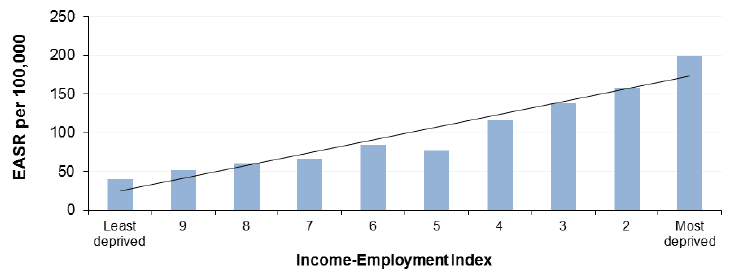
Trends in relative inequalities
Although there was a clear increase in relative inequalities between 1997 and 2001, there has been no clear trend in the years since despite some year-to-year fluctuations.
Relative inequalities peaked in 2011, before dropping sharply in 2012 to their lowest level since 1998. In 2013, relative inequalities increased such that RII is now in line with its level in 2001-2004 and similar to the levels observed in 2007-2010.
Since 1999, death rates have typically ranged between approximately five and six times higher in the most deprived areas compared to the least deprived.
Figure 11.2 Relative index of inequality (RII): mortality aged 15-44y Scotland 1997-2013
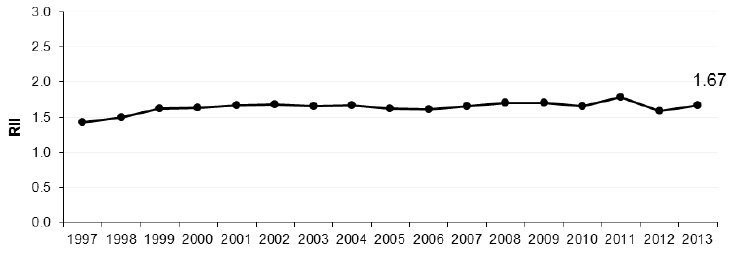
Trends in absolute inequalities
The absolute gap between the most and least deprived areas in all-cause mortality between ages 15 and 44 reached its lowest level in 2013, with death rates of 199.7 and 40.1 per 100,000 respectively (a gap of 159.6 per 100,000).
The gap had ranged between 183.6 and 219.4 per 100,000 in the years between 1998 and 2011, and has reduced in the two most recent years, following a sharper reduction in death rates in the most deprived areas.
Figure 11.3 Absolute Gap: Mortality 15-44y, Scotland 1997-2013 (European Age-Standardised Rates per 100,000)
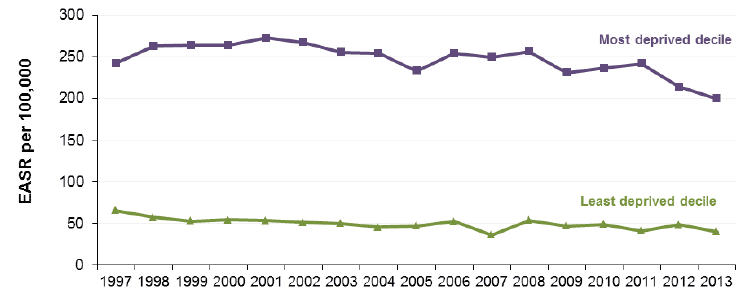
Table 11.1: Trends in all-cause mortality (aged 15-44), 1997-2013
| Number of all-causes deaths | Target population size | Rate per 100,000 (EASR) | |
|---|---|---|---|
| 1997 | 2,440 | 2,158,030 | 116.3 |
| 1998 | 2,507 | 2,142,787 | 119.4 |
| 1999 | 2,507 | 2,129,794 | 119.0 |
| 2000 | 2,501 | 2,118,568 | 118.7 |
| 2001 | 2,509 | 2,111,242 | 119.0 |
| 2002 | 2,566 | 2,102,670 | 122.0 |
| 2003 | 2,461 | 2,094,408 | 116.9 |
| 2004 | 2,409 | 2,088,563 | 114.7 |
| 2005 | 2,305 | 2,091,415 | 109.3 |
| 2006 | 2,482 | 2,091,581 | 118.3 |
| 2007 | 2,461 | 2,097,902 | 117.5 |
| 2008 | 2,443 | 2,096,495 | 117.5 |
| 2009 | 2,389 | 2,092,065 | 115.1 |
| 2010 | 2,229 | 2,087,635 | 108.6 |
| 2011 | 2,262 | 2,092,311 | 110.8 |
| 2012 | 2,071 | 2,077,902 | 102.8 |
| 2013 | 1,990 | 2,064,867 | 100.1 |
Table 11.2: Trends in deaths from assault, drug-related deaths and probable suicides, 1997-2013
| Deaths from assault | Drug related deaths | Probable suicides | ||||
|---|---|---|---|---|---|---|
| Number | EASR per 100,000 | Number | EASR per 100,000 | Number | EASR per 100,000 | |
| 1997 | 56 | 2.6 | 196 | 8.9 | 518 | 23.9 |
| 1998 | 65 | 3.0 | 227 | 10.6 | 526 | 24.4 |
| 1999 | 86 | 4.0 | 274 | 12.9 | 529 | 24.7 |
| 2000 | 60 | 2.9 | 268 | 12.7 | 541 | 25.6 |
| 2001 | 63 | 3.0 | 289 | 13.8 | 531 | 25.3 |
| 2002 | 76 | 3.6 | 345 | 16.7 | 539 | 25.7 |
| 2003 | 71 | 3.4 | 282 | 13.6 | 456 | 21.8 |
| 2004 | 78 | 3.8 | 311 | 15.2 | 475 | 22.7 |
| 2005 | 50 | 2.4 | 277 | 13.4 | 436 | 21.0 |
| 2006 | 83 | 4.0 | 350 | 17.1 | 435 | 20.9 |
| 2007 | 54 | 2.6 | 392 | 19.1 | 453 | 21.8 |
| 2008 | 53 | 2.5 | 477 | 23.3 | 480 | 23.4 |
| 2009 | 47 | 2.3 | 436 | 21.3 | 432 | 20.8 |
| 2010 | 54 | 2.6 | 384 | 18.9 | 423 | 20.5 |
| 2011 | 53 | 2.6 | 454 | 22.5 | 420 | 20.5 |
| 2012 | 37 | 1.9 | 416 | 20.8 | 375 | 18.3 |
| 2013 | 35 | 1.7 | 354 | 17.9 | 356 | 17.7 |
Contact
Email: Craig Kellock
There is a problem
Thanks for your feedback